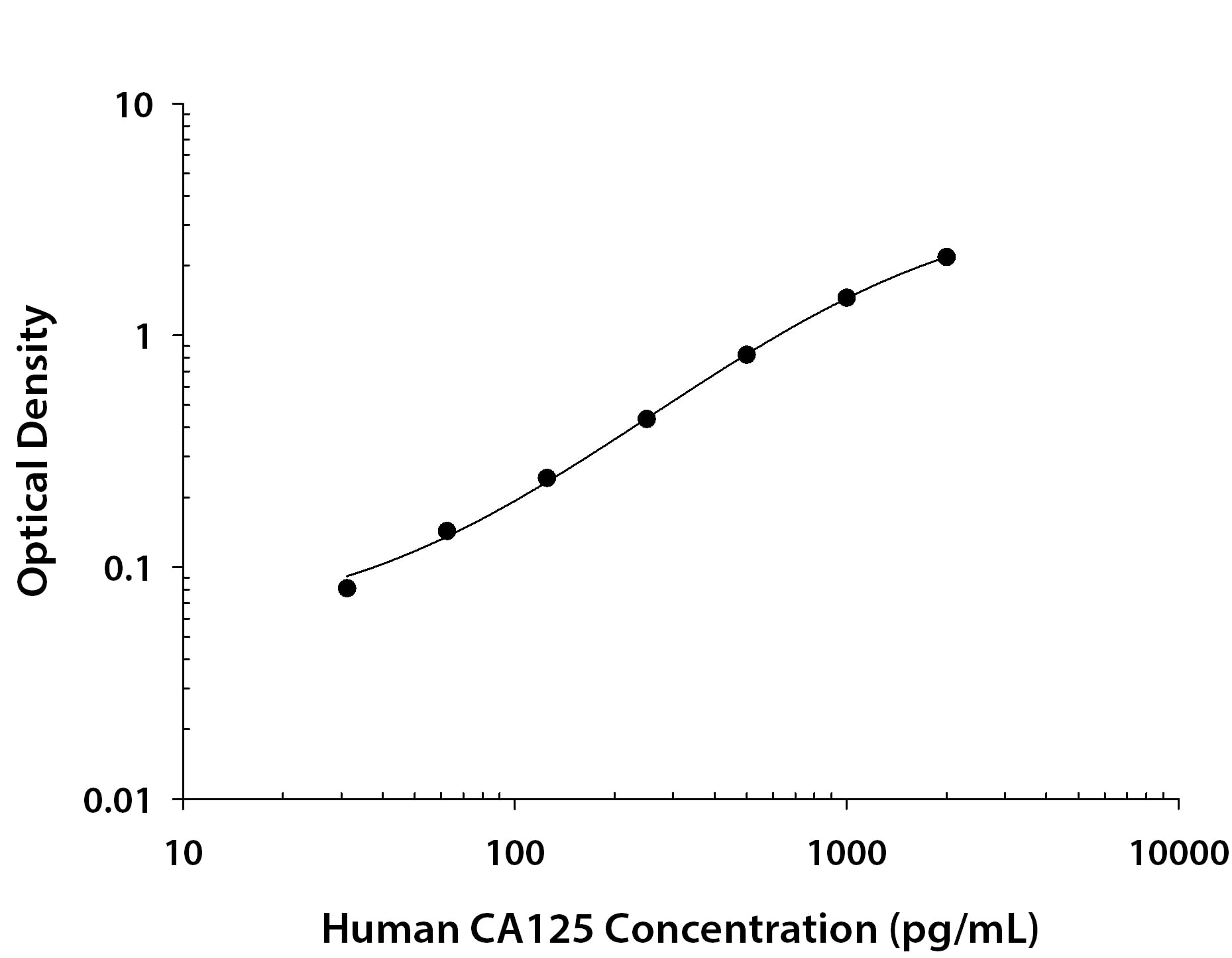Human CA125/MUC16 Antibody
R&D Systems, part of Bio-Techne | Catalog # AF62981

Key Product Details
Species Reactivity
Applications
Label
Antibody Source
Product Specifications
Immunogen
Met13360-Gln14347 (Met13472Thr & Gln13957Lys)
Accession # NP_078966.2
Specificity
Clonality
Host
Isotype
Scientific Data Images for Human CA125/MUC16 Antibody
Human CA125/MUC16 ELISA Standard Curve.
Recombinant Human CA125/MUC16 protein was serially diluted 2-fold and captured by Mouse Anti-Human CA125/MUC16 Monoclonal Antibody (Catalog # MAB56092) coated on a Clear Polystyrene Microplate (Catalog # DY990). Sheep Anti-Human CA125/MUC16 Antigen Affinity-purified Polyclonal Antibody (Catalog # AF62981) was biotinylated and incubated with the protein captured on the plate. Detection of the standard curve was achieved by incubating Streptavidin-HRP (Catalog # DY998) followed by Substrate Solution (Catalog # DY999) and stopping the enzymatic reaction with Stop Solution (Catalog # DY994).Applications for Human CA125/MUC16 Antibody
ELISA
This antibody functions as an ELISA detection antibody when paired with Mouse Anti-Human CA125/MUC16 Monoclonal Antibody (Catalog # MAB56092).
This product is intended for assay development on various assay platforms requiring antibody pairs. We recommend the Human CA125/MUC16 DuoSet ELISA Kit (Catalog # DY5609-05) for convenient development of a sandwich ELISA or the Human CA125/MUC16 Quantikine ELISA Kit (Catalog # DCA125) for a complete optimized ELISA.
Formulation, Preparation, and Storage
Purification
Reconstitution
Formulation
Shipping
Stability & Storage
- 12 months from date of receipt, -20 to -70 °C as supplied.
- 1 month, 2 to 8 °C under sterile conditions after reconstitution.
- 6 months, -20 to -70 °C under sterile conditions after reconstitution.
Background: CA125/MUC16
MUC16, also known as the CA125 antigen, is a mucin protein that may be found in type I transmembrane or secreted forms that are used monitor the progress of epithelial ovarian cancer therapy (1, 2). Expression of isoforms, proteolytic cleavage, and heavy N- and O- linked glycosylation produce forms of human MUC16 that can vary from 1148 to 22152 amino acids (aa) in length and 200 - 5000 kDa in size (1, 2). The 22152 aa form contains ser/thr-rich N-terminal tandem repeats, 4 LRR (Leu-rich repeat) domains, 56 SEA (sea urchin sperm protein, enterokinase and agrin) domains, a transmembrane domain, and a 31 aa cytoplasmic domain that includes a tyrosine phosphorylation site (1-4). SEA domains are ~120 aa in length, contain conserved residues including potential O-glycosylation sites and a pair of cysteines, and are often found in transmembrane mucins (3). The protein produced by R&D Systems represents aa 13360-14347 of the full sequence and includes the last 6 SEA domains. It shares 68% aa identity with canine MUC16. MUC16 is over-expressed by tumor cells including ovarian and mesothelial cancers (5). The transmembrane form can adhere to mesothelin in the peritoneum, facilitating metastasis of ovarian cancer to the peritoneal cavity (5-7). MUC16 also binds galectin-1 on immune cells and enhances its expression on tumor cells (8). MUC16-expressing tumors adhere to NK cells, down-regulate CD16 and suppress NK response, which may promote immune evasion (9, 10). MUC16 is also cyclically expressed in the endometrium and may contribute to immune privilege during pregnancy (10). In the eye, MUC16 and other mucins protect the cornea and keep it hydrated. It is altered on the conjunctival epithelium of patients with non-Sjogren dry eye syndrome (11).
References
- Yin, B. W. T. K. O. Lloyd, 2001, J. Biol. Chem. 276:27371.
- Maeda, T. et al. (2004) J. Biol. Chem. 279:13174.
- Fendrick, J. L. et al. (1997) Tumour Biol. 18:278.
- Swissprot accession Q8WXI7.
- Kaneko, O. et al. (2009) J. Biol. Chem. 284:3739.
- Rump, A. et al. (2004) J. Biol. Chem. 279:9190.
- Gubbels, J. A. A. et al. (2006) Mol. Cancer 5:50.
- Seelenmeyer, C. et al. (2003) J. Cell Sci. 116:1305.
- Patankar, M. S. et al. (2005) Gynecol. Oncol. 99:704.
- Belisle, J. A. et al. (2007) Immunology 122:418.
- Blalock, T. D. et al. (2007) Invest. Ophthalmol. Vis. Sci. 48:4509.
Long Name
Alternate Names
Entrez Gene IDs
Gene Symbol
UniProt
Additional CA125/MUC16 Products
Product Documents for Human CA125/MUC16 Antibody
Product Specific Notices for Human CA125/MUC16 Antibody
For research use only
